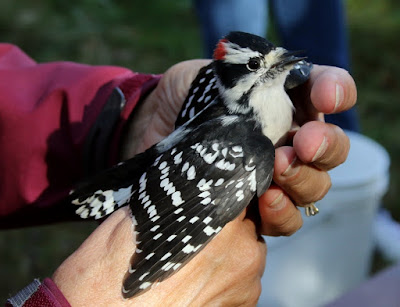By Beth Sullivan
Happily ( hopefully ),
we still have some lovely days ahead of us to be out in the yard and
woods. This year we seem to have an abundance of debris left on the
ground by the wind storms of this past month. As stewards we can’t
possibly take all the limbs and branches to the land fill. We know
there are many good uses for what Mother Nature has left behind from
her annual tree shake-out.
 |
| A Song Sparrow perches on top of a brush pile but later will find refuge inside. |
A great deal of what
has come down will stay on the ground, settling closer and closer to
the earth and, gradually becoming composted, will re-nourish the
soil. Bigger pieces take longer, but before they settle and rot they
are of great use to wildlife. The bark and wood remain accessible,
and are even more tempting to beetles, bugs and all sorts of
creatures, which in turn attract woodpeckers and other birds to probe
and poke. Under the wooden debris the earth often remains somewhat
warmer and soft, longer into the cold season, making great places to
shelter many kinds of invertebrates, salamanders, snakes, and other
cold blooded creatures that will ultimately retreat deeper into the
ground.
 |
| During winter the snow cover helps insulate the pile. |
Help Mother Nature
We can assist the
efforts by creating brush piles in areas where the autumn abundance
has left us plenty of material. Believe it or not there is an art
to making a good and longer-lasting brush pile that will welcome and
shelter all manner of wildlife through the winter. The CT DEEP has
a webpage dedicated to this.
Their big projects often require BIG brush piles, but it doesn’t
take heavy machinery to make a great protective place for wildlife.
In my own woods I know the piles I make are not perfect, but they
are always the places the sparrows and wrens seem to find first when
the temperature drops.
Instead
of loosely piled branches just left on the side of the trail, a
beneficial brush pile is more solidly structured for durability.
Heavier pieces are placed lowest down to provide support and
structure as well as good sized gaps close to the ground. Mid-sized
branches are criss–crossed in several layers on top next, and the
whole pile is covered with smaller pieces, especially evergreen
boughs, to add that final layer of insulation and protection. Think
of the pile covered deep in snow in the dead of winter. The smaller
spaces within are protected from biting winds and even retain some
warmth from the ground in the face of sub-freezing temperatures.
Small mammals can stash food nuts, seeds, and grasses eliminating the
need to venture out. Birds also will find protection within. Larger
predators cannot squeeze into the small spaces of sanctuary in the
pile.
When
you get out for a hike over these next months of cold, notice places
where stewards have left piles along the trails. Some are simply
piles which work fine for shelter, but some are more purposefully
constructed to give our wildlife an extra hand.
 |
| Brush does not need to go to a landfill, but consolidated into useful piles. |
 |
| To make a good brush pile, put bigger pieces on the bottom, making nice holes. |
 |
| Then pile on brush for shelter |
Watch that pile
If
you still have the time and energy to do a bit more yard work, and
you are lucky enough to have access to some woody debris left over
from November storms, try out a deliberately created brush pile. If
you can make it in in a place where you can observe it from a window,
you will be rewarded with a new form of winter wildlife watching.
Keep your eyes out for birds and check for mammal tracks. One
friend had a young opossum find safety in her brush pile for the
length of a long cold winter. I like to scatter bird seed, dried
fruits and crumbled suet in and around my brush pile. It becomes a
glorified bird feeder. Your can report your observations to Project Feeder Watch here. I often
get a few unique birds at my brush pile feeder.
 |
| You don't need big equipment to make a brush pile but it helps. |
Photographs
by Beth Sullivan.




















